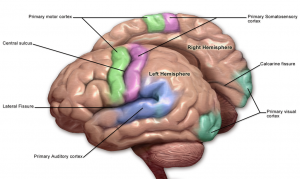“I Can’t Help it! It’s Just the Way My Brain Works!”
Sometimes it’s difficult for us to understand just what goes through the mind of a dyspraxic child and how their brain works. We know we have to be patient, that they can’t help their handwriting/memory/falling over and bumping into things because their brains work differently, but just why does this happen?
I’m going to try to explain it in non-technical terms, with as little jargon as possible. We have so much information swimming around our heads (and many of us are dyspraxic ourselves), so who needs to make things more complicated, right?
 The “Relay Race” or the “Wiring of the Brain”
The “Relay Race” or the “Wiring of the Brain”
There are two simple ways I think of, when trying to explain how the brain of someone with dyspraxia works:
1. The Relay Race. The brain functions by passing a signal from one brain cell to another, just like a relay race. Imagine the signal is the baton in a relay race–sometimes the baton gets dropped, gets handed over too late, gets twisted and battered in the changeover etc. This doesn’t mean that the baton is completely lost, or that it will necessary happen in the next race–a bit of training and you can help to get the baton over the line.
This is why there is no cure for dyspraxia, but also explains how we learn coping mechanisms to ensure the next time we try to write a ‘5’ the right way, we won’t always drop the baton and write a weird-looking ‘3’. Training and learning strategies can help to see the baton safely on its way to the finish line. We learn to cope and to get the baton over the line in whatever way works for us, so dyspraxia symptoms can improve over time.
 2. Wiring of the Brain. There is a problem with the internal wiring of the brain. Messages aren’t properly transferred from the brain to the body–the brain isn’t wired up correctly, so sometimes the current gets through in a wobbly fashion, sometimes it gets lost, other times it causes a complete meltdown.
2. Wiring of the Brain. There is a problem with the internal wiring of the brain. Messages aren’t properly transferred from the brain to the body–the brain isn’t wired up correctly, so sometimes the current gets through in a wobbly fashion, sometimes it gets lost, other times it causes a complete meltdown.
In order for this current to get passed from one brain cell to the next in a smooth way, it needs to pass through the cell walls. These walls consist almost entirely of fats, and around 20% of this wall (or cell membrane) is made of fatty acids like Omega-3. This is why an omega-3 supplement may help a child with dyspraxia. It’s thought that omega-3 may make it easier for signals to cross the gap between brain cells.
 A Game of Two Halves – A Bit More Scientific
A Game of Two Halves – A Bit More Scientific
The main part of the brain is divided into two halves known as the left and right hemisphere. Each of these serves a separate purpose.
Certain functions are shared between the left and right side, but each side generally works independently, each taking care of their side of things to then be put together with the other half to achieve the whole. These two sides need to work together and in harmony, in order for a function to be carried out.
The mind of someone with dyspraxia though, does not have these two halves living in harmony. They don’t know how to coordinate with each other, and are just out of sync.
It’s as if the left side receives the information, but it’s scrambled, and it needs the right side to come along and help to unjumble the information to put things in the correct order. Without the two sides of the brain coordinating, it’s no wonder that the mind gets confused over maths or how to send the message to your fingers to tie shoelaces.
 It’s Not All Bad News
It’s Not All Bad News
In true positive style, although you now know how your child’s mind works and this explains why some things are so difficult for them, I need to point out that the unique way their brains work is also in their favour.
GCHQ recently announced that they employ 120 dyslexic and dyspraxic people because the unique way their brains process information makes them particularly suitable for cracking codes.
It’s widely thought that Albert Einstein had dyspraxia–although it wasn’t a recognised condition at the time. People with dyspraxia are often very creative and imaginative as they are unencumbered by doing things in a conventional way. As Einstein himself said:
“Imagination is more important than knowledge. For knowledge is limited to all we now know and understand, while imagination embraces the entire world, and all there ever will be to know and understand.”
The world needs more imaginative thinkers and doers–who wants to be like everyone else!
References
http://www.bbc.co.uk/science/humanbody/mind/articles/intelligenceandmemory/omega_three.shtml
http://www.educational-psychologist.co.uk/sen-information/dyspraxia-checklist/
http://www.dyspraxiafoundation.org.uk/about-dyspraxia/brain/
Relay race image – with thanks to Paul W
Brain synapse image – with thanks to aboutmodafinil.com
Einstein image – public domain



My son is dyspraxic and although he is a clever boy it doesn’t come across in the classroom be it in his school work or on the occasional time hi speaks up in class. He is also painfully shy and has been bullied.
This is the exact problem we have too, Naomi. It’s very frustrating when we can see how smart they are, but it just doesn’t come across in the classroom environment. I have a shy dyspraxic daughter and it’s so hard because it’s not like there’s a cure or treatment for this. I’m so sorry he has been bullied–I hope that’s all in the past. Please know that you aren’t alone xx.
Good post. I definitely love this site. Stick with it!
I had the pleasure of working with a dyspraxic child. I just loved listening to the stories he told and the determination he showed when he found things difficult. I often thought of him as a bit of an Einstein and after reading this, can now see why.
What a lovely comment–thank you, Kathy. I’m glad you saw working with a dyspraxic child as a pleasure 🙂 My daughter’s LSA is often saying how she loves the determination and the will to try everything. It’s so fabulous that so many people have found this article helpful; it makes it all worthwhile. Thanks again 🙂
My daughter is Dyspraxic and hers comes off as body wiring making her terribly clumsy and she often gets tired easily which leads to a bit of extra weight. She is incredibly smart and tested in the gifted range and we are so lucky to have teachers that encourage her intellectual side.